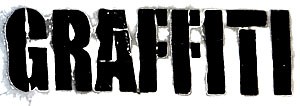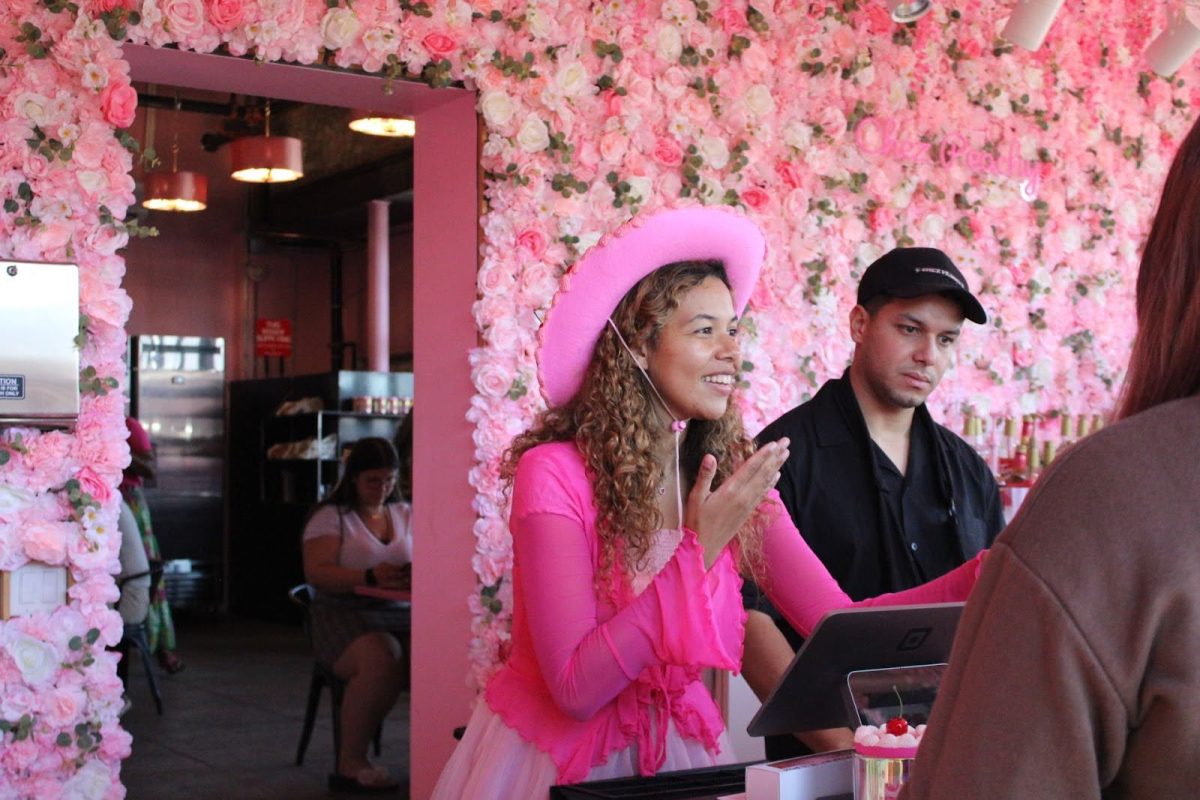The clean-up
“”On a daily basis we can range from anywhere to five to 10 locations on campus that have been hit by graffiti, but we can take it off as quick as they can put it up,”” said Christopher Kopach, associate director of facilities management. “”If they put a sticker on a stop sign, we’ll remove it. If they paint on a building, we’ll remove it. If they scribble in a bathroom stall, we’ll remove it.””
Kopach said he estimates more then $20,000 a year is spent by facilities management to clean up graffiti on campus property.
“”This is money we spend that we don’t receive funding for,”” Kopach said. “”It’s vandalizing our buildings and it’s affecting our state dollars that could be used on making this campus a better environment for students.””
Every morning the facilities management ground staff tours the campus, each member assigned to a specific region of campus with the goal of having all graffiti found and removed by the end of the day, Kopach said.
Facilities management deals with so much graffiti on a daily basis that they recently purchased a soda wash machine that is used specifically to remove paint from concrete or brick surfaces, Kopach said.
Despite dedicating so much time and money towards keeping the campus graffiti-free, neither facilities management nor anyone else on campus, including University of Arizona Police Department, keep statistics on how much graffiti occurs, where it occurs, or what it consists of.
“”We have no official numbers on how much it happens or by whom,”” Kopach said. “”If I were to throw out a number then I’d be taking a guess.””
Given the amount of graffiti on campus that facilities management has to clean up on a given day, it seems as though the amount of graffiti found on campus remains constant, Kopach said.
Defining art and crime
Kopach argues that there is a difference between art and vandalism and that the graffiti his crew cleans up day-in and day-out is exclusively vandalism.
“”It’s not for me to say whether I like it or not, to each his own, but if it’s on public property then it’s not art, it’s vandalism,”” Kopach said. “”There’s a proper place and time for artwork – that’s what the art department is for. If it’s on a canvas or paper, that’s a whole other story, but when somebody paints a big whale on the side of a building and it’s in red paint, it’s graffiti.””
When we see graffiti, it’s just somebody trying to make a point and get attention…that in itself is a statement
Frank Romero, UAPD
Officer Frank Romero of the UAPD’s crime prevention unit, says the issue of graffiti is over the expression of art versus the mentality of destruction.
“”If you’ve got an item or structure that was created one way, to serve a certain purpose and look a certain way, a building, a bench, a sign or even a tree, if someone alters that item and purposely intended to alter the appearance of that item, then it’s graffiti,”” Romero said. “”Whether it says ‘Susie loves Johnny’ or ‘whatever rules’, it’s all graffiti.””
The graffiti found on campus doesn’t seem to be related to criminal street gangs, but rather a result of frustrated people with no other outlet, Romero said.
“”When we see graffiti, it’s just somebody trying to make a point and get attention,”” Romero said. “”The whale and all the other things we see around campus mean something to somebody, even if that something is nothing. That in itself is a statement.””
In March, UAPD started responding to the “”Smiley whale”” that had been “”tagged”” up all over campus, including some greek houses, Romero said.
“”We don’t think the whale is connected to any gangs,”” Romero said. “”I don’t know what they would call themselves if it did. The whalers?””
UAPD has seen a trend of increased graffiti that is fueled by current events, Romero said.
“”After 9/11 we saw an increase in graffiti, a lot of it focused negatively towards those people believed to be responsible for the attacks,”” Romero said. “”Anytime we see something like that happen in the news we get more graffiti.””
Graffiti often is the product of people with communication problems and who fear to express themselves in another way, Romero said.
A graffiti artist’s response
Dan Tepper, a photography senior, considers himself a graffiti artist.
Tepper and a friend opened up an art gallery, 36 Chambers, located downtown, to not only display their artwork – whether it be graffiti, photographs or various other mediums – but also to provide a space for others to show off their skills.
“”(36 Chambers) is just a practice space for me and my roommate to practice our graffiti in a legal environment where nobody can hassle us,”” Tepper said. “”When we saw the place we were just like, ‘We have to get this place,’ and everything was white and dead and lifeless. And now that we’ve moved in and put layers and layers of graffiti on the walls and the place is alive and, I think, looks a lot better.””
36 Chambers also has an open policy toward outside artists coming in and contributing to the graffiti covered walls, said Tepper, who also lives in the gallery.
“”We ask that people don’t tag up our bedrooms, the kitchen and the bathroom in the back or any of the artwork displayed, but otherwise people can come in and do whatever they want,”” Tepper said.
Despite providing a space to display graffiti legally, some of the essence of graffiti fails to translate to the gallery from the streets, Tepper said.
“”Graffiti is so much more than the final product,”” Tepper said. “”It’s the preparation. It’s the illegal act. It’s getting away with it. It’s going back and taking pictures of it. But in Tucson, for the most part, none of that is possible because everything will get buffed within the next 24 hours. Everything gets painted over all the time, so there’s no history.””
Tepper said it’s not worth the time and effort to do graffiti in Tucson because of the rapid cleanup and the harsh penalties.
“”One of the problems graffiti faces is people are quick to say ‘it’s all either gang activity and it’s all vandalism,”” Tepper said. “”You can’t do that, you can’t say graffiti is something and graffiti isn’t something. If you pick up a spray can and put it on a wall it’s graffiti, it’s art and it’s usually illegal.””
Police and people who have no understanding of graffiti as an art will always be against graffiti because it’s everywhere and it’s prevalent, but that’s what graffiti is about, Tepper said.
“”That’s what’s cool about graffiti – no matter what, you can’t get enough people to paint over it and speak against it,”” Tepper said. “”It will still be there no matter what anybody does. It’s the good and the bad and the ugly.””
Most of the graffiti found on campus is being done by people who don’t take graffiti seriously as an art – which falls into the bad and ugly category, Tepper said.
“”The smiling whale guy, I don’t like what he’s doing. I think he’s making a mess,”” Tepper said. “”That’s just some toy. I’ve seen that guy’s stuff around town. The guy needs to practice a lot more; I’m not impressed.””
Inspiration by way of whale
Chrystal Richt, an ecology and evolutionary biology junior, said she sees the “”smiling whale”” all over the UA campus and the city, but sees it as more of a fish than a whale.
“”You can tell the difference between somebody whose doing something to vandalize something and someone whose trying to make a statement or just do something for fun,”” Richt said. “”But when I see that fish, I like that fish.””
In May the “”smiling fish”” appeared on a trailer owned by Richt’s boyfriend’s band, which allowed the opportunity for Richt to do some artwork of her own.
“”I added the ocean and a shark to it,”” Richt said. “”We used spray-paint and painted a shark and some seaweed. It was like we were playing along with whoever is doing this, like we were saying ‘hi’ back.””
Whether or not someone finds the fish and other graffiti offensive depends on what got vandalized and the situation, Richt said.
Graffiti is so much more than the final product …
It’s getting away with it. It’s going back and taking pictures of it.
– Dan Tepper, photography senior
“”I don’t encourage vandalism, but I like the idea that it was taken light-heartedly,”” Richt said.
A lot of work goes into making stencils and planning out elaborate graffiti pieces and it is a serious art form, Richt said.
“”It’s somebody who’s alive doing something, and if they graffiti on a building then suddenly it’s not just a building anymore, it’s somebody’s little creation on the building, and I kind of like that,”” Richt said.









